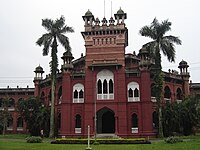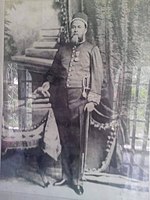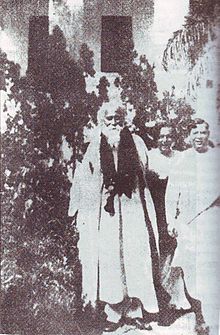| This article needs additional citations for verification. Please help improve this article by adding citations to reliable sources. Unsourced material may be challenged and removed. Find sources: "History of the University of Dhaka" – news · newspapers · books · scholar · JSTOR (May 2016) (Learn how and when to remove this message) |
The University of Dhaka was established in 1921 as the first university in East Bengal. Following demands from Nawab Sir Khwaja Salimullah Bahadur and others, Viceroy Lord Hardinge proposed on 2 February 1912, that a new university should be established in this partition of Bengal.

Introduction
The University was established as compensation for the annulment of the 1905 Partition of Bengal. The partition had established East Bengal and Assam as a separate province, with Dhaka as its capital. However, the partition was abolished in 1911. In 1913, public opinion was solicited before the university scheme was given its final shape, and the Secretary of State approved it in December 1913. The first vice-chancellor of the university was Philip Joseph Hartog, who had been academic registrar of the University of London for 17 years.
Foundation and early days
Established in 1921, under the Dacca University Act 1920 of the Indian Legislative Council, the university is modelled after British universities. Academic activities started on 1 July 1921, with three faculties: Arts, Science, and Law. Classes were taught in 12 departments: Sanskrit and Bengali, English, Education, History, Arabic and Islamic Studies, Persian and Urdu, Philosophy, Economics and Politics, Physics, Chemistry, Mathematics, and Law. Initially there were three dormitories for students: Salimullah Muslim Hall, Dacca Hall and Jagannath Hall.
Opposition
Many notable people, especially Hindu leaders, opposed the then government's intention to establish the University of Dhaka. Advocate Dr Rashbehari Ghosh told viceroy that the establishment of a separate university at Dhaka would promote 'an internal partition of Bengal'. They also contended that "Muslims of Eastern Bengal were in large majority cultivators and they would benefit in no way by the foundation of a university". Asutosh Mukherjee, vice-chancellor of Calcutta University, also opposed its creation. According to Major General M. A. Matin, Rabindranath Tagore attended the Gorer Math Rally which was against the formation of the university. However, the validity of his statement remains debatable.
Establishment and the British era


Under Vice-Chancellor Mahmud Hussain, the University consolidated its fundamental focus on academics. It also made national headlines when he extended an invitation to then-President of Pakistan, Ayub Khan, who declined citing 'security reasons'. This was the first of many subsequent refusals from high-ranking officials to visit East Pakistan.
Students from 1921 to 1948
There were few students in the early years of the University of Dhaka. Enrollment in the first few years is shown in the table below:
| Session | Number of Muslim students | Number of total students |
| 1929–30 | 427 | 1300 (Except the training college and Medical Schools) |
| 1930–31 | 399 | 1300 |
| 1930–34 | 1027 | |
| 1934–35 | 933 (Including 39 female students) | |
| 1937–38 | 595 | 1527 |
| 1939–40 | 673 | 1527 |
| 1940–41 | 600 | 1633 |
| 1945–46 | 1000 (Including 90 female students) | |
| 1946–47 | 1092 (Including 100 female students) | |
| 1947–48 | 1693 (Including 72 female students) |


University of Dhaka in the Liberation war (1970s)
Main article: 1971 Dhaka University massacreTeachers who were killed in 1971
Students and teachers of the University of Dhaka played a vital role in the 1971 Liberation War of Bangladesh. The Ordinance of 1961 was annulled and substituted by the Dacca University Order of 1973., The new Order restored autonomy, and provided a democratic atmosphere for the teachers and students where they could engage freely in academic and intellectual pursuits.
Teachers at the University of Dhaka who were killed during the liberation war include:
| Name of Teacher | Institution |
|---|---|
| Dr. Mohammad Mortuza | Chief medical officer of the university |
| Giasuddin Ahmed | University of Dhaka |
| Dr. ANM Muniruzzaman | University of Dhaka |
| Dr. Jyotirmoy Guha Thakurta | University of Dhaka |
| AN Munir Chowdhury | University of Dhaka |
| Mofazzal Haider Chowdhury | University of Dhaka |
| Dr. Abul Khair | University of Dhaka |
| Dr. Serajul Hoque Khan | University of Dhaka |
| Rashidul Hasan | University of Dhaka |
| Anwar Pasha | University of Dhaka |
| Dr. GC Dev | University of Dhaka |
| Dr. Fazlur Rahman | University of Dhaka |
| Dr. Faizul Mohi | University of Dhaka |
| Abdul Muktadir | University of Dhaka |
| Sarafat Ali | University of Dhaka |
| Sadat Ali | University of Dhaka |
| AR Khan Khadim | University of Dhaka |
| Santosh C Bhattacharya | University of Dhaka |
| Mohammad Sadeq | University Laboratory School |
| Anudippayan Bhattachariya | University of Dhaka |
References
- ^ Sajahan Miah (2012). "University of Dhaka". In Sirajul Islam and Ahmed A. Jamal (ed.). Banglapedia: National Encyclopedia of Bangladesh (Second ed.). Asiatic Society of Bangladesh.
- "Sir Philip Hartog, a Great Educationist". The Times. London. 28 June 1947. p. 6.
was appointed Academic Registrar to the University of London, and held that office with great efficiency for 17 17 years ... Hartog was made first vice-chancellor.
- "Prospectus" (PDF). University of Dhaka. Archived from the original (PDF) on 25 February 2012. Retrieved 29 November 2012.
- "University of Dhaka".
- ফারহানা পারভীন. "ঢাকা বিশ্ববিদ্যালয় প্রতিষ্ঠায় বিরোধিতা করেছিলেন যারা". BBC News বাংলা. BBC Bangla. Retrieved 23 August 2024.
- Matin, M. A. আমাদের স্বাধীনতা সংগ্রামের ধারাবাহিকতা এবং প্রাসঙ্গিক কিছু কথা [Amader Swadhinata Sangramer Dharabahikata abong proasangik kichu katha] (in Bengali). Dhaka: Ahmad Publishing House. ISBN 9841105348.
{{cite book}}: Check|isbn=value: checksum (help) - "Prof Anisuzzaman says claims Rabindranath opposed Dhaka University are baseless".
- Dhaka University & the History of East Bengal: An interview of Professor Abdur Razzaq, written by-Sardar Fazlul Karim সরদার ফজলুল করিম রচিত ঢাকা বিশ্ববিদ্যালয় ও পুর্ব বঙ্গীয় সমাজ: অধ্যাপক আবদুর রাজ্জাকের আলাপচারিতা
External links
- University of Dhaka Official website
- History of the Formation of Dhaka University Our Bangla. Retrieved: 2007-07-2
| University of Dhaka | |
|---|---|
| History | |
| Culture | |
| Institutes | |
| Facilities | |
| Residential halls | |
| Related | |